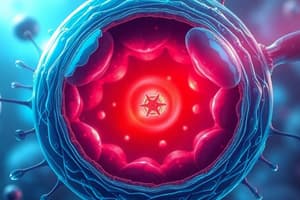Podcast
Questions and Answers
Where is ribosomal RNA synthesized and ribosome sub-units assembled?
Where is ribosomal RNA synthesized and ribosome sub-units assembled?
- Nucleolus (correct)
- Endoplasmic reticulum
- Chromatin granules
- Mitochondria
Why is the nucleolus referred to as the 'pacemaker of the cell'?
Why is the nucleolus referred to as the 'pacemaker of the cell'?
- It plays a central role in protein synthesis through ribosome production (correct)
- It synthesizes lipids and carbohydrates
- It controls DNA replication
- It regulates cell division
Where are chromosomal threads condensed into a tight coil?
Where are chromosomal threads condensed into a tight coil?
- Endoplasmic reticulum
- Mitochondria
- Chromatin granules (correct)
- Nucleolus
Which organelle in the cytoplasm produces lipids and carbohydrates, and has no ribosomes?
Which organelle in the cytoplasm produces lipids and carbohydrates, and has no ribosomes?
What is the function of rough ER?
What is the function of rough ER?
Which organelle is primarily composed of protein and RNA, smaller than nucleoli, and seen only in nondividing cells?
Which organelle is primarily composed of protein and RNA, smaller than nucleoli, and seen only in nondividing cells?
What is the main function of the cell membrane?
What is the main function of the cell membrane?
Which statement accurately describes the cytoplasm?
Which statement accurately describes the cytoplasm?
Where is the nucleus usually located within a cell?
Where is the nucleus usually located within a cell?
Which part of the cell membrane is fluid-like?
Which part of the cell membrane is fluid-like?
What are inclusions in a cell?
What are inclusions in a cell?
How do pores in the nuclear membrane function?
How do pores in the nuclear membrane function?
Flashcards are hidden until you start studying
Study Notes
Cell Structure and Organelles
- The cell is the basic unit of the body's structure, consisting of the nucleus, cytoplasm, and cell membrane.
Nucleus
- The nucleus is a specialized spherical mass of protoplasm, usually located at the center of the cell.
- The nuclear membrane is composed of 2 layers with a small space between them.
- Ribosomes are sometimes attached to the outer membrane, while the innermost membrane is smooth.
- The two membranes fuse to form a thin single layer, forming a pore, which serves as an avenue for material exchange between the nucleoplasm and cytoplasm.
Nucleolus
- The nucleolus is the site where ribosomal RNA is synthesized and ribosome subunits are assembled.
- It plays a central role in regulating protein synthesis, earning it the title "pacemaker of the cell".
Chromatin Granules
- Chromatin granules are composed primarily of protein and RNA.
- They are smaller than nucleoli, have an irregular shape and size, and are only seen in non-dividing (interphase) cells.
- Chromatin granules are areas where chromosome filaments or threads are condensed by being wound into a tight coil.
- These chromosomal threads contain genes, which determine heredity.
Organelles in the Cytoplasm
- The endoplasmic reticulum (ER) is a network of channels or tubules pervading the entire cytoplasm.
- The ER is also composed of a lipid bilayer, similar to the cell membrane and nuclear membrane.
- There are two kinds of ER: smooth ER and rough ER.
- Smooth ER produces lipids or carbohydrates and glycogen, and has no ribosomes.
- Rough ER produces and synthesizes proteins and is scattered with regular ribosomes.
Cell Membrane
- The cell membrane, also known as the plasmalemma, is a lipid membranous bilayer.
- It is composed predominantly of phospholipids with a hydrophilic polar head (outside) and a hydrophobic nonpolar tail (inner part).
- The cell membrane is fluid, limiting, and separates the cell's contents from its external environment.
Studying That Suits You
Use AI to generate personalized quizzes and flashcards to suit your learning preferences.




